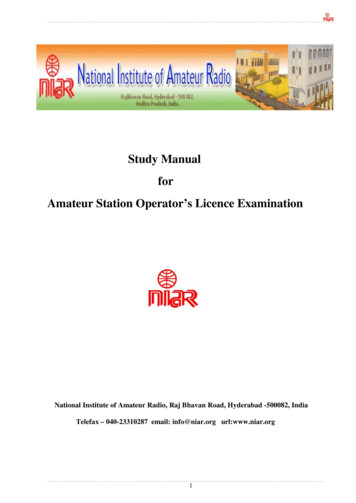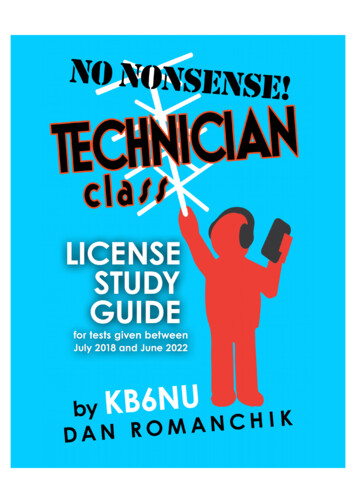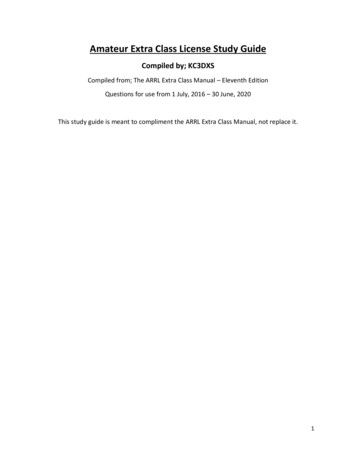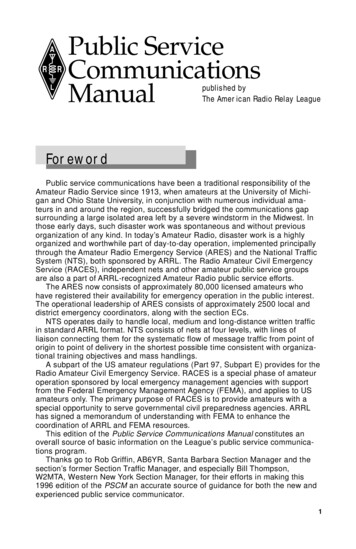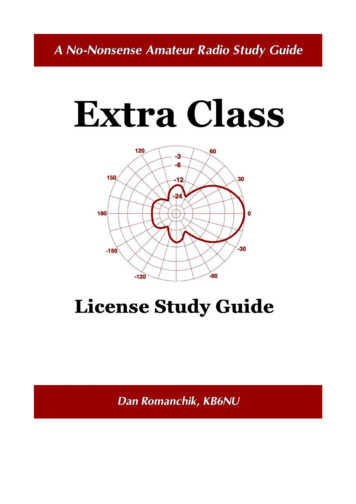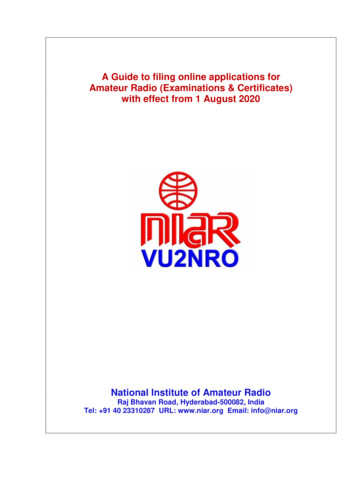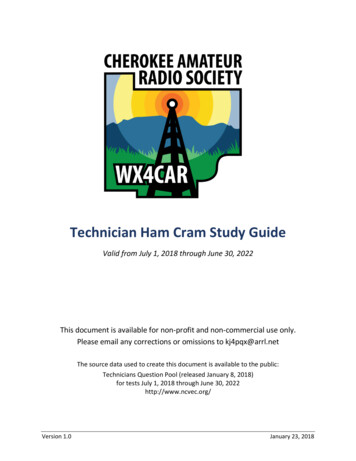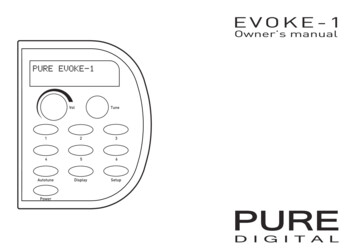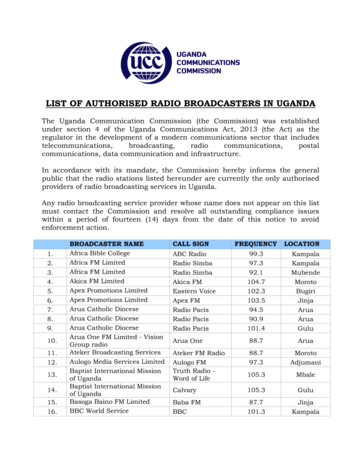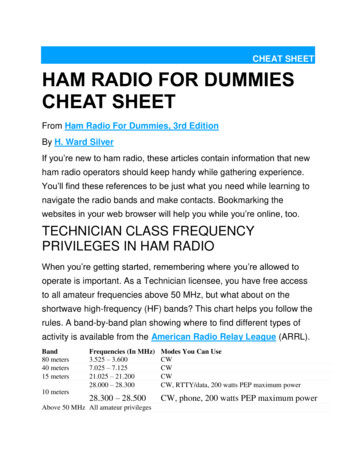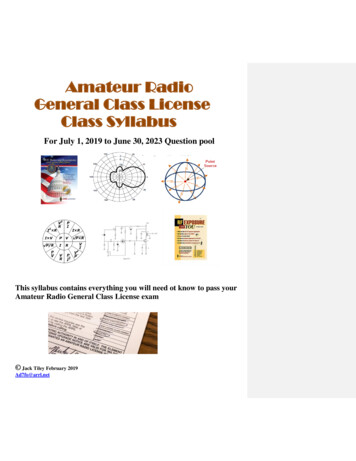
Transcription
Amateur RadioGeneral Class LicenseClass SyllabusFor July 1, 2019 to June 30, 2023 Question poolThis syllabus contains everything you will need ot know to pass yourAmateur Radio General Class License exam Jack Tiley February 2019Ad7fo@arrl.net
General License Class SyllabusFor July 1, 2019 to June 30, 2023With March 15, 2019 errataAll questions are shown in this syllabus are exactly as they will appear in the exam with only the correct answer shown(in green bold text). Question numbers have been included so you can go to the ARRL General Class License Manual, orthe published question pool itself at http://ncvec.org/page.php?id 364 to see the additional choices in the exam foreach question.This material is based on the published 2019 General Class License question pool, effective July 1, 2019, with additionalinformation added by the author (in italicized blue text).Many of the illustrations used in this syllabus were copied from the ARRL Handbook CD-ROM, scanned from thelicense manual with permission from the copyright owner, ARRL, as well as other public sites on the web. Thisdocument has been written to assist students and instructors and may be distributed freely as long as no charge forthe material is made (except for reproduction costs associated with delivering paper copies or electronic copies on CDROM’s or other media) and this note of copyright permission is not removed. This syllabus is copyrighted by theAuthorAn electronic file for this syllabus may downloaded from www.ad7fo.com. It is recommended that if this is posted toanother web site and that only the web page be referenced to be sure the latest revision is always downloaded.Additional information and resources to help you study for the Technician Class License can be found on the ARRL website (www.arrl.net). The ARRL web site has articles, resources and reference materials on all aspects of the examquestions and Amateur Radio in general.About the AuthorEducation: Electrical Engineering, Penn State UniversityWork Experience:Hewlett Packard: (retired in 2004) Twenty-three years at the RF Products Division in Spokane WA – 1981 to 2004 - Regional Sales Support,Application Engineering, World Wide Sales Management, Systems Development and Product Management Eleven years at Valley Forge PA sales office, from 1969 until 1981 - Engineering Technical Support, TechnicalCustomer Training and Field Sales EngineerAmerican Electronics Laboratories: Nine years working in and managing a Metrology (Calibration) Laboratory in Colmar Pennsylvania. Responsiblefor a team of Technicians that maintained a wide range of test instruments and their calibration traceability to theNational Bureau of Standards (NBS) [now the National Institute of Standards and Technology (NIST)].Jerrold Electronics: Two years as a Technician at the Jerrold Electronics R&D Laboratory in Hatboro, PA working on RF testequipment and cable TV equipment.
Hobbies: Amateur Radio (Extra Class License Holder) Test Equipment Electronics in general.Amateur Radio Activities: Teaching and mentoring Developing and teaching Technician, General and Extra License Classes Developed and teach ARRL EMCOMM class with a power point presentation I have developed.o Wrote and presented more than twenty, one-hour or less technical talks for local ham radio clubs (Manyare available from the Authors web page www.ad7fo.com ).o Provide a radio and general-purpose test table every year at the Spokane Hamfest for folks to test theirradios and other electronic Hamfest treasures. Attending as many Pacific Northwest Hamfest’s as I canARRL Appointments: ARRL EWA Section Manager ARRL VE (Volunteer Examiner) ARRL Technical Specialist for Spokane area ARRL Registered Instructor ARRL Certified EMCOMM instructorOther: Member of the Inland Empire VHF Club Member of the Spokane County ARES/RACES Member of Greater Spokane County COAD (Community Organizations Active in Disasters) Member of the Annual Spokane Hamfest Planning committee
Syllabus OverviewThe Syllabus is intended either for classroom study or for self-study in pursuit of the Amateur Radio General ClassLicense and to assist instructors in teaching a class. It may be distributed freely if no charge for the material is made.Reproduction costs associated with delivering paper or electronic copies on CD-ROM’s may be charged and the note ofcopyright permission on page 2 is not removed.Any modified copies must contain a note that the original material by the author has been modified and contain thename and contact information of the person making the changes. An MS Word version is available from the Author atad7fo@arrl.net for those who want to customize this material for classes they teach.Question numbers are shown in bold text like this, T1A03 so you can go to the ARRL Technician Class License Manual, orthe question pool itself, to see the actual questions and other answer choices that will be in the exam. If there is an FCC(Federal Communications Commission) Part 97 rule relating to the answer it is shown following the question number.The FCC regulation reference number like this, T1A07 [97.3(a)(45)]All questions are shown with only the correct answer in bold green text, which in the authors view makes it easier whenyou see the other choices oin your exam to identify the correct answer because you have not seen the wrong answers.Additional information has been added by the author (in italicized blue text) for some of the questions to explain theanswer or show calculations. In addition, some graphics have also been added for additional clarification.A copy of the ARRL General Class License Manual is not required. Everything you need to study for your license exam isin this syllabus. The author recommends if you want more technical background that you acquire a copy of the ARRLHandbook (available from ARRL web site or other retailers and book stores). The Handbook will cover your technicalneeds for all three licenses and will be a great reference after you are licensed. And at a cost of approximately 50 (arecent copy will suffice if you find a used one at a Hamfest).While every effort was made to insure the accuracy of the material herein, this material was prepared by an ordinaryhuman being, and it is likely that a few typographical and other errors remain. Author welcomes corrections and can becontacted at ad7fo@arrl.netYou can check the author’s web site www.ad7fo.com to insure you have the latest revision of the syllabus.
Requirements for Students1. You will need a printed or down loaded copy of this syllabus to study from prior to the class. The Class will be taughtdirectly from a PowerPoint version of the syllabus. The syllabus can be downloaded from www.ad7fo.com. A printed,and bound copy of this syllabus can be purchased from The UPS Store located at 2910 East 57th Avenue #5, Spokane,WA 99223, Phone (509) 448-6368 (ask for Richard, KE7DQC) for around 15. These can be picked up at the store or canbe ordered and shipped to a student’s address. All the possible questions in the exam are covered in this syllabus.2. A copy of Part 97 of the FCC rules is recommended and a PDF version can be downloaded for free from the ARRLwebsite at http://www.arrl.org/part-97-amateur-radio or purchased in printed form from the ARRL Web site or othersources. The FCC rules require that you to have access to a copy of the part 97 rules (printed copy or on line from yourcomputer) after you receive your license.3. You will need a basic scientific calculator that you are familiar with operating that is capable of normal mathfunctions, square roots, trigonometry and Base 10 Log functions (all basic scientific calculators have these functions).Not all these functions are needed for the General Exam but will be needed when you go for the Extra exam. Scientificcalculators like the Texas Instruments TI30 are available from office supply stores for around 20 or less from officesupply stores if you do not already have one. It is recommended you do not purchase a programmable calculator as itwill not be allowed in the test session. Cell phone calculators are never allowed in test sessions.4. A desire to learn and to ask questions. If you do not understand something that is being taught be sure you ask theinstructor.5. You must take and pass the General Class written exam (element 3) There are 35 questions on the exam. All questions are multiple choice (4 choices). Questions only come from the published Question Pool (all possible questions are covered in this syllabus). The number of possible questions for each topic area is fixed and shown for each question group in the test. You must have 26 correct answers to pass the exam (no more than 9 incorrect answers). There are online practice sites with the real test questions previously listed where you can take practiceexams. Listed below are a few sites where you can find practice mradiolicenseexam.com6. You should read through this syllabus before the class. You are not expected to learn and understand everything youread, but by being familiar with what will be covered, you can identify those areas where you need to focus on and/orbring up questions during the class. Do not be intimidated. The material will be made easy to understand by yourinstructor(s). You can check for ham radio clubs in your area for a local Ham (known as Elmer’s) that can help youprepare.
ELECTRICAL AND ELECTRONIC BASICS(Background for the technical portion of the exam)Metric system Basics for Ham RadioGiga XXXX 1,000,000,000 (one thousand million) XXXXMega XXXX 1,000,000 (one million) times XXXXKilo XXXX 1,000 (one thousand) XXXXCenti XXXX 1/100 (one hundredth) XXXXMilli XXXX 1/1,000 (one thousandth) XXXXMicro XXXX 1/1,000,000 (one millionth) XXXXNano XXXX 1/1,000,000,000 (one thousandth of a Micro) XXXXPico XXXX 1/1,000,000,000,000 (one millionth of a millionth) XXXXExample: XXXX is the value you are expressing such as Volts, Amperes, Ohms, Watts, etc. One Kilovoltwould be 1,000 Volts, one megaohms would be 1,000,000 ohmsVoltage, Resistance and Current Flow:Everything we use in our amateur station requires a power source that delivers a specific Voltage and Current.Voltage is commonly referred to as Electro Motive Force (EMF) instead of volts. This is like the water pressurein a dam. Current, the flow of electricity, is measured in amperes and is commonly represented by the letter I.Current is like the flow of water in a pipe at the bottom of the dam. The amount of water flowing (current)would be limited by the diameter of the pipe (resistance) and the pressure (Voltage/EMF) exerted by theheight of the water in the dam. In an electronic circuit the current flow would be limited by the EMF (voltage)and the resistance to current flow (resistor) measured in ohms.If we know the voltage and the resistance in a circuit, we can calculate the current that would be flowing usingthe following expression:Current in amperes (I) is equal to the EMF in volts (E) divided by the resistance in ohms (R).I (amperes) E (voltage) R (resistance)For example: if you have a 12-volt battery connected across a 6-ohm resistor the current flowing would be 2amperes.Current V R or 12 volts 6 Ohms or Current 2 amperes
Power:Power is work done by electricity and is defined as the voltage across a circuit multiplied by the current flowingthrough the circuit.Examples:A circuit connected to 120-volt power outlet that draws 10 amperes would be consuming 1200 watts of power.Power voltage times the current or Power 120 x 10 or 1200 wattsA circuit powered by a 12-volt battery that draws 200 milliamperes (ma) would consume 2.4 watts.Power voltage times the current or Power 12 x 0.20 or 2.4 wattsWe have two kinds of commonly encountered sources of electric power:Direct Current:Direct Current (DC) is a voltage that has two terminals, one positive and one negative. Typically, DC power isavailable from batteries, accessory jacks in vehicles, and plug-in power suppliesCommonly used batteries for amateur radio applications include the following:Alkaline and Zinc Carbon cells that produce 1.5 V - available in AAA, AA, C and D cells. These batteries arenot rechargeable.
Lithium batteries that produce 1.5 or 3 volts. A typical example would be AAA, AA and coin cells. Thesebatteries are not rechargeable.Nickel Cadmium (NICAD), Nickel Metal Hydride (NIMH) batteries that produce 1.2 volts, and are available inAAA, AA, C, D cells, and custom shapes. These batteries are rechargeable.Flooded Lead Acid batteries that produce 12 volts. Examples are automotive batteries and deep cycle marinebatteries. These contain a liquid electrolyte (sulfuric acid) and cannot be used tipped over, laid on their side.These batteries are rechargeable. These batteries contain Sulphuric acid and release Hydrogen gas whilecharging so ventilation is required.Sealed Lead Acid batteries – Gel Cells and AGM (Absorbed Glass Mat) batteries that are available in 12-voltversions (other Voltages are available bur for Amateur Radio the 12-volt version is the most commonly used).They are sealed and use a “gelled” electrolyte and they can be operated in any position. They have high currentratings ranging from smaller ones with a 1 ampere hour rating up to 80 ampere hours and more. Thesebatteries are rechargeable.
Alternating CurrentAlternating current is a voltage that alternates between equal positive and negative values. This is what isavailable from the common AC wall outlet in our homes.The 120 Volts from the outlets in our home is the equivalent of a value that would provide the same heatingeffect (or work) as a DC voltage of the same value. voltage and is known as the RMS (root Mean Square) valueof the AC voltage. The heating effect of AC is less than the peak value because the voltage is continuouslychanging over the time for each cycle. The peak value of an AC RMS voltage is 1.414 times the RMS value.Therefore, the peak voltage for a 120 Volt RMS coming from the outlet in our homes would be 1.414 times 120volts or 169.68 volts Peak or 339.36 volts peak to peak (measured from the positive peak to the negative peakof the AC waveform).For a pure sine wave the equivalent RMS value is 0.707 times the peak value. Conversely the peak voltage canbe calculated as 1.414 times the RMS Value.Examples:The peak voltage present in standard 120V RMS AC line voltage is 1.414 x 120V or approx. 170 volts peak.The peak to peak (maximum negative to maximum positive peaks) would be two times the peak voltage orapprox. 340 V Peak to Peak.PP 2x Peak or PP 2 x (120 x 1.414) or PP 2 x 169.7or PP 339.4 VoltsAn AC voltage that reads 65 volts on an RMS meter will have a peak to peak voltage of 184 Volts.Peak to peak Voltage 2 x RMS x 1.414 or PP 2 x 65 x 1.414 or PP 183.8 V PPFREQUENCY:If we start at the first positive peak to the next positive peak of one cycle of our sine wave you will observe thatit crosses through Zero twice in the cycle.The time it takes for one cycle of a sine wave is the period of the sine wave. A 100 Hz sine wave has a period of.01 Seconds (or 10 milliseconds).Frequency is the number of times that an event happens in one second of time. Shown below is a single cycle ofa sine wave, as it would be displayed on an oscilloscope. To determine its frequency, you would divide the timein seconds for one cycle into 1.00.
Examples:What is the frequency of a sine wave with a 10 ms (millisecond) period for one cycle?F 1 time or F 1 0.010 or F 100HzWhat is the frequency of a sine wave with a 1 µs (microsecond) period for one cycle?F 1 time or F 1 0.000001 or F 1,000,000 Hz or 1 MHzWhat is the frequency of a sine wave with a 15 µs period for one cycle?F 1 time or F 1 0.000015 or F 66,666 Hz or 66.666 KHzWhat is the frequency of a sine wave with a 16.666 millisecond period for one cycle?F 1 time or F 1 0.0166 or F 60.00 HzWavelength:Wavelength is the distance a wave will travel during one cycle usually expressed in meters. Light travels at avelocity of approximately 300 million meters per second (actual speed of light is 299,792,458 meters everysecond) in free space. Wavelength is important in amateur radio when designing and building antennas.We frequently refer to the frequency bands in amateur radio by their approximate wavelength in meters. Forinstance, 146 Megahertz (MHz) would be the 2-meter band. Wavelength is easily calculated as using thefollowing equation:Wavelength equals the speed of light (in meters per second) divided by the frequencyWavelength 300,000,000 frequency in Hertz) or to simplifyWavelength 300 Frequency (in megahertz)For the 146 MHz example above this would be:300,000,000 divided by 146,000,000; or since both values are in millions simply,300 146 or 2.054 metersThis is an important relationship to remember since there are questions in the exam relating to wave length for aspecific frequency or the frequency for a given wavelength.In amateur radio we frequently refer to our frequencies in terms of approximate wavelength. Since wefrequently operating in the megahertz band, we can simplify our conversion to wavelength by dividing thefrequency in megahertz (MHz) into 300. For example:A 146 MHz signal would be in the 2-meter band --- 300 146 2.054-metersA 4.0 MHz signal would be in the 75-meter band --- 300 4 75-metersA frequency of 1 MHz (1,000,000 Hertz) which is in the middle of the AM broadcast band will travel 300meters in one complete cycle.300,000,000 1,000,000 or 300 1 or 300 meters
RF Signals and ModulationRadio frequencies are simply sine waves like we see coming out of the outlet at home except at a much higherfrequency (rate). Radio signals in the AM Broadcast band are operating from 500,000 hertz to 1,700,000 Hertz.This frequency range can be expressed in kilohertz (thousands of hertz as 500 KHz to 1,700 KHz), or inmegahertz (millions of hertz) as 0.500 MHz to 1.700 MHzThe frequency of a signal is just the carrier frequency, that is the frequency with no information applied. Whenwe add voice or data to the carrier we are “modulating” or adding information. Simple modulation can beaccomplished by varying the frequency of the carrier (Frequency Modulation or FM) or varying the amplitudeof the carrier amplitude (Amplitude Modulation or AM).Amplitude Modulation (AM)Frequency Modulation (FM)Digital ModulationThere are many other forms of modulation other than simple amplitude and frequency modulation used inAmateur Radio here are a few:
2019-2023 General Class – FCC Element 3 Syllabus – Effective July 1, 2019Revision 1.2SUBELEMENT G1 – COMMISSION’S RULES [5 Exam Questions – 5 Groups]G1A – General class control operator frequency privileges; primary and secondary allocationsG1B – Antenna structure limitations; good engineering and good amateur practice; beacon operation; prohibitedtransmissions; retransmitting radio signalsG1C – Transmitter power regulations; data emission standards; 60-meter operation requirementsG1D – Volunteer Examiners and Volunteer Examiner Coordinators; temporary identification; element creditG1E – Control categories; repeater regulations; third-party rules; ITU regions; automatically controlled digitalstationSUBELEMENT G2 – OPERATING PROCEDURES [5 Exam Questions – 5 Groups]G2A – Phone operating procedures; USB/LSB conventions; breaking into a contact; VOX operation (1 examquestion)G2B – Operating courtesy; band plans; emergencies, including drills and emergency communications (1 examquestion)G2C – CW operating procedures and procedural signals; Q signals and common abbreviations; full break-in (1exam question)G2D – Volunteer Monitoring Program; HF operations (1 exam question)G2E – Digital operating procedures (1 exam question)SUBELEMENT G3 – RADIO WAVE PROPAGATION [3 Exam Questions – 3 Groups]G3A – Sunspots and solar radiation; ionospheric disturbances; propagation forecasting and indices (1 examquestion)G3B – Maximum Usable Frequency; Lowest Usable Frequency; propagation (1 exam question)G3C – Ionospheric layers; critical angle and frequency; HF scatter; Near Vertical Incidence Skywave (1 examquestion)SUBELEMENT G4 – AMATEUR RADIO PRACTICES [5 Exam Questions – 5 groups]G4A – Station operation and setup (1 exam question)G4B – Test and monitoring equipment; two-tone testG4C – Interference to consumer electronics; grounding; DSP (1 exam question)G4D – Speech processors; S meters; sideband operation near band edges (1 exam question)G4E – HF mobile radio installations; alternative energy source operation (1 exam question)SUBELEMENT G5 – ELECTRICAL PRINCIPLES [3 Exam Questions – 3 Groups]G5A – Reactance; inductance; capacitance; impedance; impedance matching (1 exam question)G5B – The decibel; current and voltage dividers; electrical power calculations; sine wave root-mean-square(RMS) values; PEP calculations (1 exam question)G5C – Resistors, capacitors, and inductors in series and parallel; transformers (1 exam question)SUBELEMENT G6 – CIRCUIT COMPONENTS [2 Exam Questions – 2 Groups]G6A – Resistors; capacitors; inductors; rectifiers; solid-state diodes and transistors; vacuum tubes; batteries (1exam question)G6B – Analog and digital integrated circuits (ICs); microprocessors; memory; I/O devices; microwave ICs(MMICs); display devices; connectors; ferrite cores (1 exam question)
SUBELEMENT G7 – PRACTICAL CIRCUITS [3 Exam Questions – 3 Groups]G7A – Power supplies; schematic symbols (1 exam question)G7B – Digital circuits; amplifiers and oscillators (1 exam question)G7C – Receivers and transmitters; filters; oscillators (1 exam question)SUBELEMENT G8 – SIGNALS AND EMISSIONS [3 Exam Questions – 3 Groups]G8A – Carriers and modulation: AM; FM; single sideband; modulation envelope; digital modulation;overmodulation (1 exam question)G8B – Frequency mixing; multiplication; bandwidths of various modes; deviation; duty cycle; intermodulation(1 exam question)G8C – Digital emission modes (1 exam question)SUBELEMENT G9 – ANTENNAS AND FEED LINES [4 Exam Questions – 4 Groups]G9A – Antenna feed lines: characteristic impedance and attenuation; SWR calculation, measurement, andeffects; matching networks (1 exam question)G9B – Basic antennas (1 exam question)G9C – Directional antennas (1 exam question)G9D – Specialized antennas (1 exam question)SUBELEMENT G0 – ELECTRICAL AND RF SAFETY [2 Exam Questions – 2 Groups]G0A – RF safety principles, rules and guidelines; routine station evaluation (1 exam question)G0B – Station safety: electrical shock, safety grounding, fusing, interlocks, wiring, antenna and tower safety (1exam question)
SUBELEMENT G1 – COMMISSION’S RULES[5 Exam Questions – 5 Groups]G1A – General class control operator frequency privileges; primary and secondaryallocationsG1A01 [97.301(d)]On which HF/MF bands is a General class license holder granted all amateur frequency privileges?160 meters, 60 meters, 30 meters, 17 meters, 12 meters, and 10 metersG1A02 [97.305]On which of the following bands is phone operation prohibited?30 metersG1A03 [97.305]On which of the following bands is image transmission prohibited?See answer above30 metersG1A04 [97.303 (h)]Which of the following amateur bands is restricted to communication only on specific channels, rather thanfrequency ranges? 60 meters
G1A05 [97.301(d)]Which of the following frequencies is in the General class portion of the 40-meter band (in ITU Region 2)?7.250 MHzCommented [JT1]:G1A06 [97.301(d)]Which of the following frequencies is within the General class portion of the 75-meter phone band?3900 kHzG1A07 [97.301(d)]Which of the following frequencies is within the General class portion of the 20-meter phone band?14305 kHzG1A08 [97.301(d)]Which of the following frequencies is within the General class portion of the 80-meter band?3560 kHz3560 is in the RTTY portion of the band (red area)
G1A09 [97.301(d)]Which of the following frequencies is within the General class portion of the 15-meter band?21300 kHzG1A10 [97.301(d)]Which of the following frequencies is available to a control operator holding a General class license?A. 28.020 MHzB. 28.350 MHzC. 28.550 MHzD. All these choices are correctG1A11 [97.301]When General class licensees are not permitted to use the entire voice portion of a band, which portion of thevoice segment is generally available to them? The upper frequency endG1A12 [97.303]Which of the following applies when the FCC rules designate the Amateur Service as a secondary user on aband? Amateur stations can use the band only if they do not cause harmful interference to primary usersG1A13 [97.303(5)(h)(2)(j)]What is the appropriate action if, when operating on either the 30-meter or 60-meter bands, a station in theprimary service interferes with your contact? Move to a clear frequency or stop transmittingG1A14 [97.301(d)]Which of the following may apply in areas under FCC jurisdiction outside of ITU Region 2?Frequency allocations may differITU – International Telecommunications Union is divided into three regions, the US is in region 2
G1A15 [97.205(b)]What portion of the 10-meter band is available for repeater use? The portion above 29.5 MHzNote: this is not shown on the ARRL band planG1B – Antenna structure limitations; good engineering and good amateur practice;beacon operation; prohibited transmissions; retransmitting radio signalsG1B01 [97.15(a)]What is the maximum height above ground to which an antenna structure may be erected without requiringnotification to the FAA and registration with the FCC, provided it is not at or near a public use airport?200 feetG1B02 [97.203(b)]With which of the following conditions must beacon stations comply? There must be no more than onebeacon signal transmitting in the same band from the same station locationG1B03 [97.3(a)(9)]Which of the following is a purpose of a beacon station as identified in the FCC rules? Observation ofpropagation and receptionG1B04 [97.113(c)]Which of the following transmissions is permitted? Occasional retransmission of weather and propagationforecast information from U.S. government stationsG1B05 [97.111((5)(b)]Which of the following one-way transmissions are permitted? Transmissions necessary to assist learningthe International Morse codeG1B06 [97.15(b), PRB-1, 101 FCC 2d 952 (1985)]Under what conditions are state and local governments permitted to regulate Amateur Radio antenna structures?Amateur Service communications must be reasonably accommodated, and regulations must constitutethe minimum practical to accommodate a legitimate purpose of the state or local entityG1B07 [97.113(a)(4)]What are the restrictions on the use of abbreviations or procedural signals in the Amateur Service?They may be used if they do not obscure the meaning of a message
G1B08 [97.101(a)]When choosing a transmitting frequency, what should you do to comply with good amateur practice?A. Ensure that the frequency and mode selected are within your license class privilegesB. Follow generally accepted band plans agreed to by the Amateur Radio communityC. Monitor the frequency before transmittingD. All these choices are correctG1B09 [97.203(d)]On what HF frequencies are automatically controlled beacons permitted?28.20 MHz to 28.30 MHzAn amateur radio propagation beacon is a radio beacon, whose purpose is the investigation ofthe propagation of radio signals. Most radio propagation beacons use amateur radio frequencies. They canbe found on LF, MF, HF, VHF, UHF, and microwave frequencies.Got to https://www.ncdxf.org/beacon/ for more information and frequencies for beacon stations.G1B10 [97.203(c)]What is the power limit for beacon stations? 100 watts PEP outputG1B11 [97.101(a)]Who or what determines “good engineering and good amateur practice,” as applied to the operation of anamateur station in all respects not covered by the Part 97 rules? The FCCG1B12 [97.111(a)(1)]When is it permissible to communicate with amateur stations in countries outside the areas administered by theFederal Communications Commission? When the contact is with amateurs in any country except thosewhose administrations have notified the ITU that they object to such communicationsOnly Yemen and North Korea currently do not allow ham radio by its citizensG1C – Transmitter power regulations; data emission standards; 60-meter operationrequirementsG1C01 [97.313(c)(1)]What is the maximum transmitting power an amateur station may use on 10.140 MHz? 200 watts PEP outputPEP, Peak envelope power is the peak power of the voice (or other Modulation type). Single sideband poweris a function of the modulation signal. The louder you talk the more peak power your transmission has (upto the limit of your transmitter)G1C02 [97.313]What is the maximum transmitting power an amateur station may use on the 12-meter band? 1500 watts PEPoutput
G1C03 (A) [97.303(h)(1)]What is the maximum bandwidth permitted by FCC rules for Amateur Radio stations transmitting on USBfrequencies in the 60-meter band? 2.8 kHzG1C04 [97.313(a)]Which of the following limitations apply to transmitter power on every amateur band?Only the minimum power necessary to carry out the desired communications should be usedG1C05 [97.313]What is the limit for transmitter power on the 28 MHz band for a General Class control operator?1500 watts PEP outputG1C06 [97.313]What is the limit for transmitter power on the 1.8 MHz band? 1500 watts PEP outputG1C07 [97.305(c), 97.307(f)(3)]What is the maximum symbol rate permitted for RTTY or data emission transmission on the 20-meter band?300 baudMaximum Symbol rates (baud)BandMax Symbol RateSignal BandwidthBelow 10 Meters300 baud1 KHz10 Meters1200 baud1 KHz6 & 2 meters19.6 K baud20 K
Amateur Radio Activities: Teaching and mentoring Developing and teaching Technician, General and Extra License Classes Developed and teach ARRL EMCOMM class with a power point presentation I have developed. o Wrote and presented more than twenty, one-hour or less technic
